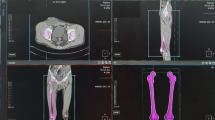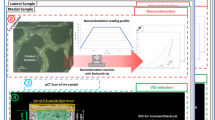Abstract
Background
It is still unclear whether femoral fracture risk is positively or negatively altered in individuals with overweight. Considering the lack of studies including men with overweight, this study aimed to analyze regional specificities in mechano-structural femoral properties (femoral neck and intertrochanteric region) in adult male cadavers with overweight compared to their normal-weight age-matched counterparts.
Methods
Ex-vivo osteodensitometry, micro-computed tomography, and Vickers micro-indentation testing were performed on femoral samples taken from 30 adult male cadavers, divided into the group with overweight (BMI between 25 and 30 kg/m2; n = 14; age:55 ± 16 years) and control group (BMI between 18.5 and 25 kg/m2; n = 16; age:51 ± 18 years).
Results
Better quality of trabecular and cortical microstructure in the inferomedial (higher trabecular bone volume fraction, trabecular thickness, and cortical thickness, coupled with reduced cortical pore diameter, p < 0.05) and superolateral femoral neck (higher trabecular number and tendency to lower cortical porosity, p = 0.043, p = 0.053, respectively) was noted in men with overweight compared to controls. Additionally, the intertrochanteric region of men with overweight had more numerous and denser trabeculae, coupled with a thicker and less porous cortex (p < 0.05). Still, substantial overweight-induced change in femoral osteodensitometry parameters and Vickers micro-hardness was not demonstrated in assessed femoral subregions (p > 0.05).
Conclusions
Despite the absence of significant changes in femoral osteodensitometry, individuals with overweight had better trabecular and cortical femoral micro-architecture implying higher femoral fracture resistance. However, the microhardness was not significantly favorable in the individuals who were overweight, indicating the necessity for further research.

This is a preview of subscription content, access via your institution
Access options
Subscribe to this journal
Receive 12 print issues and online access
$259.00 per year
only $21.58 per issue
Buy this article
- Purchase on Springer Link
- Instant access to full article PDF
Prices may be subject to local taxes which are calculated during checkout



Similar content being viewed by others
Data availability
Data generated during this study are available from the corresponding author (MD) upon justified request.
References
Palermo A, Tuccinardi D, Defeudis G, Watanabe M, D’Onofrio L, Lauria AP, et al. BMI and BMD: The potential interplay between obesity and bone fragility. Int J Environ Res Public Health. 2016;13:544.
Hebebrand J, Holm JC, Woodward E, Baker JL, Blaak E, Durrer Schutz D, et al. A proposal of the European association for the study of obesity to Improve the ICD-11 diagnostic criteria for obesity based on the three dimensions etiology, degree of adiposity and health risk. Obes Facts. 2017;10:284–307.
Shapses SA, Pop LC, Wang Y. Obesity is a concern for bone health with aging. Nutr Res. 2017;39:1–13.
Anandacoomarasamy A, Caterson I, Sambrook P, Fransen M, March L. The impact of obesity on the musculoskeletal system. Int J Obes. 2008;32:211–22.
Cawsey S, Padwal R, Sharma AM, Wang X, Li S, Siminoski K. Women with severe obesity and relatively low bone mineral density have increased fracture risk. Osteoporos Int. 2014;26:103–11.
Tang X, Liu G, Kang J, Hou Y, Jiang F, Yuan W, et al. Obesity and risk of hip fracture in adults: a meta-analysis of prospective cohort studies. PLoS One. 2013;8:6–12.
Prieto-Alhambra D, Premaor MO, Fina Avilés F, Hermosilla E, Martinez-Laguna D, Carbonell-Abella C, et al. The association between fracture and obesity is site-dependent: A population-based study in postmenopausal women. J Bone Miner Res. 2012;27:294–300.
Premaor MO, Compston JE, Fina Avilés F, Pagès-Castellà A, Nogués X, Díez-Pérez A, et al. The association between fracture site and obesity in men: a population-based cohort study. J Bone Miner Res. 2013;28:1771–7.
Premaor MO, Ensrud K, Lui L, Parker RA, Cauley J, Hillier TA, et al. Risk factors for nonvertebral fracture in obese older women. J Clin Endocrinol Metab. 2011;96:2414–21.
Li X, Gong X, Jiang W. Abdominal obesity and risk of hip fracture: a meta-analysis of prospective studies. Osteoporos Int. 2017;28:2747–57.
Greco EA, Fornari R, Rossi F, Santiemma V, Prossomariti G, Annoscia C, et al. Is obesity protective for osteoporosis? Evaluation of bone mineral density in individuals with high body mass index. Int J Clin Pract. 2010;64:817–20.
Migliaccio S, Greco EA, Fornari R, Donini LM, Lenzi A. Is obesity in women protective against osteoporosis? Diabetes Metab Syndr Obes Targets Ther. 2011;4:273–82.
Rikkonen T, Sund R, Sirola J, Honkanen R, Poole KES, Kröger H. Obesity is associated with early hip fracture risk in postmenopausal women: a 25-year follow-up. Osteoporos Int. 2021;32:769–77.
Nielson CM, Marshall LM, Adams AL, Leblanc ES, Cawthon PM, Ensrud K, et al. BMI and fracture risk in older men: the osteoporotic fractures in men study (MrOS). J Bone Miner Res. 2011;26:496–502.
Lee JS, Kawakubo K, Sato H, Kobayashi Y, Haruna Y. Relationship between total and regional bone mineral density and menopausal state, body composition and life style factors in overweight Japanese women. Int J Obes. 2001;25:880–6.
Jadzic J, Mijucic J, Nikolic S, Djuric M, Djonic D. The comparison of age- and sex-specific alteration in pubic bone microstructure: a cross-sectional cadaveric study. Exp Gerontol. 2021;150:111375.
Djonic D, Milovanovic P, Nikolic S, Ivovic M, Marinkovic J, Beck T, et al. Inter-sex differences in structural properties of aging femora: implications on differential bone fragility: a cadaver study. J Bone Miner Metab. 2011;29:449–57.
Cauley JA. Estrogen and bone health in men and women. Steroids. 2015;99:11–15.
Shanbhogue VV, Støving RK, Frederiksen KH, Hanson S, Brixen K, Gram J, et al. Bone structural changes after gastric bypass surgery evaluated by HR-pQCT: a two-year longitudinal study. Eur J Endocrinol. 2017;176:685–93.
Yu EW, Thomas BJ, Brown JK, Finkelstein JS. Simulated increases in body fat and errors in bone mineral density measurements by DXA and QCT. J Bone Miner Res. 2012;27:119–24.
De Laet C, Kanis JA, Oden A, Johansson H, Johnell O, Delmas PD, et al. Body mass index as a predictor of fracture risk: a meta-analysis. Osteoporos Int. 2005;16:1330–8.
Caffarelli C, Alessi C, Nuti R, Gonnelli S. Divergent effects of obesity on fragility fractures. Clin Interv Aging. 2014;9:1629–36.
Link TM, Heilmeier U. Bone quality — beyond bone mineral density. Semin Musculoskelet Radiol. 2016;20:269–78.
Evans AL, Paggiosi MA, Eastell R, Walsh JS. Bone density, microstructure and strength in obese and normal weight men and women in younger and older adulthood. J Bone Miner Res. 2015;30:920–8.
Bredella MA, Lin E, Gerweck AV, Landa MG, Thomas BJ, Torriani M, et al. Determinants of bone microarchitecture and mechanical properties in obese men. J Clin Endocrinol Metab. 2012;97:4115–22.
Andersen S, Frederiksen KD, Hansen S, Brixen K, Gram J, Støving RK. Bone structure and estimated bone strength in obese patients evaluated by high-resolution peripheral quantitative computed tomography. Calcif Tissue Int. 2014;95:19–28.
Giner M, Montoya MJ, Miranda C, Vázquez MA, Miranda MJ, Pérez-Cano R. Influence of obesity on microarchitecture and biomechanical properties in patients with hip fracture. Rev Osteoporos y Metab Miner. 2017;9:20–6.
Sornay-Rendu E, Boutroy S, Vilayphiou N, Claustrat B, Chapurlat RD. In obese postmenopausal women, bone microarchitecture and strength are not commensurate to greater body weight: the OS des femmes de Lyon (OFELY) study. J Bone Miner Res. 2013;28:1679–87.
Folli F, Sabowitz BN, Schwesinger W, Fanti P, Guardado-Mendoza R, Muscogiuri G. Bariatric surgery and bone disease: from clinical perspective to molecular insights. Int J Obes. 2012;36:1373–9.
Djuric M, Djonic D, Milovanovic P, Nikolic S, Marshall R, Marinkovic J, et al. Region-specific sex-dependent pattern of age-related changes of proximal femoral cancellous bone and its implications on differential bone fragility. Calcif Tissue Int. 2010;86:192–201.
Jadzic J, Milovanovic P, Cvetkovic D, Ivovic M, Tomanovic N, Bracanovic M, et al. Mechano-structural alteration in proximal femora of individuals with alcoholic liver disease: implications for increased bone fragility. Bone. 2021;150:116020.
Beck TJ. Hip structural analysis (HSA) program. Cent Dis Control Prev. 2002;43:1–10.
Orwoll ES, Marshall LM, Nielson CM, Cummings SR, Lapidus J, Cauley JA, et al. Finite element analysis of the proximal femur and hip fracture risk in older men. J Bone Miner Res. 2009;24:475–83.
Ruiz Wills C, Olivares AL, Tassani S, Ceresa M, Zimmer V, González Ballester MA, et al. 3D patient-specific finite element models of the proximal femur based on DXA towards the classification of fracture and non-fracture cases. Bone. 2019;121:89–99.
Miura M, Nakamura J, Matsuura Y, Wako Y, Suzuki T, Hagiwara S, et al. Prediction of fracture load and stiffness of the proximal femur by CT-based specimen specific finite element analysis: cadaveric validation study. BMC Musculoskelet Disord. 2017;18:1–8.
Ito M, Nishida A, Koga A, Ikeda S, Shiraishi A, Uetani M, et al. Contribution of trabecular and cortical components to the mechanical properties of bone and their regulating parameters. Bone. 2002;31:351–8.
Boivin G, Bala Y, Doublier A, Farlay D, Ste-Marie LG, Meunier PJ, et al. The role of mineralization and organic matrix in the microhardness of bone tissue from controls and osteoporotic patients. Bone. 2008;43:532–8.
Dall’Ara E, Öhman C, Baleani M, Viceconti M. The effect of tissue condition and applied load on Vickers hardness of human trabecular bone. J Biomech. 2007;40:3267–70.
Cohen A, Dempster DW, Recker RR, Lappe JM, Zhou H, Zwahlen A, et al. Abdominal fat is associated with lower bone formation and inferior bone quality in healthy premenopausal women: a transiliac bone biopsy study. J Clin Endocrinol Metab. 2013;98:2562–72.
Ng AlvinC, Melton LJ, Atkinson EJ, Achenbach SJ, Holets MF, Peterson JM, et al. Relationship of adiposity to bone volumetric density and microstructure in men and women across the adult lifespan. Bone. 2013;55:119–25.
Franco-Trepat E, Guillán-Fresco M, Alonso-Pérez A, Jorge-Mora A, Francisco V, Gualillo O, et al. Visfatin connection: present and future in osteoarthritis and osteoporosis. J Clin Med. 2019;8:1178.
Tanna N, Patel K, Moore AE, Dulnoan D, Edwards S, Hampson G. The relationship between circulating adiponectin, leptin and vaspin with bone mineral density (BMD), arterial calcification and stiffness: a cross-sectional study in post-menopausal women. J Endocrinol Investig. 2017;40:1345–53.
Acknowledgements
This study received financial support from the Science Fund of the Republic of Serbia (IDEAS program, grant no. 7749444, BoFraM project) and the Ministry of Science of the Republic of Serbia (grant no. 200110 and 451–03–1524/2023–04/18). The Authors thank Dr. Miomira Ivovic for her valuable help during DXA scanning.
Author information
Authors and Affiliations
Contributions
JJ, PM and MD conceptualized the study and used methodology. VZ and SN carried out sample collection. JJ and UA conducted data acquisition and wrote the original draft. All authors interpreted the results and provided review and editing of the manuscript. MD was responsible for project administration and funding acquisition. All authors approved the submitted version of the manuscript.
Corresponding author
Ethics declarations
Competing interests
The authors declare no competing interests.
Ethics approval
The Ethics Committee of the Faculty of Medicine, University of Belgrade confirmed that our study complied with relevant national and international standards based on the Declaration of Helsinki principles (approval no. 1322/VII-17). The Institutional Ethics Committee waived the informed consent requirement for collecting the samples included in the study.
Additional information
Publisher’s note Springer Nature remains neutral with regard to jurisdictional claims in published maps and institutional affiliations.
Rights and permissions
Springer Nature or its licensor (e.g. a society or other partner) holds exclusive rights to this article under a publishing agreement with the author(s) or other rightsholder(s); author self-archiving of the accepted manuscript version of this article is solely governed by the terms of such publishing agreement and applicable law.
About this article
Cite this article
Jadzic, J., Andjelic, U., Milovanovic, P. et al. Improved femoral micro-architecture in adult male individuals with overweight: fracture resistance due to regional specificities. Int J Obes 48, 202–208 (2024). https://doi.org/10.1038/s41366-023-01389-z
Received:
Revised:
Accepted:
Published:
Issue Date:
DOI: https://doi.org/10.1038/s41366-023-01389-z



